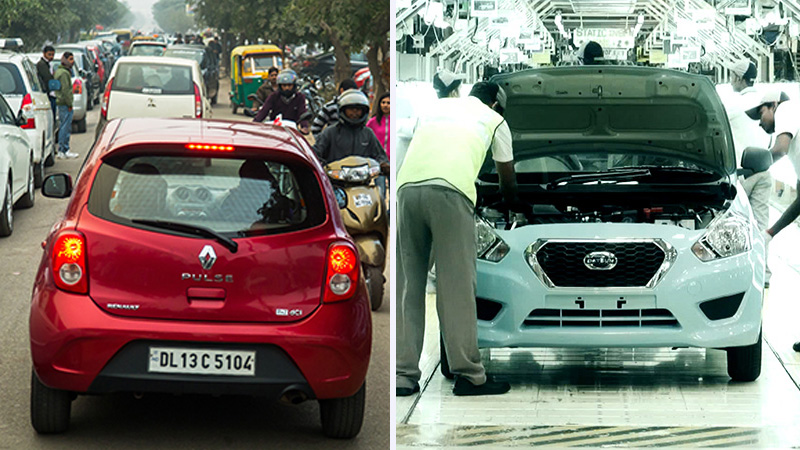
 Among the many global plants of the Renault Nissan Alliance, the factory in Oragadam, close to Chennai in India, stands out in several ways. Though other Alliance factories now also produce multiple brands, the Indian site was the first planned from the beginning as a joint facility, including shared production as well as local research and development.
Among the many global plants of the Renault Nissan Alliance, the factory in Oragadam, close to Chennai in India, stands out in several ways. Though other Alliance factories now also produce multiple brands, the Indian site was the first planned from the beginning as a joint facility, including shared production as well as local research and development.
Indian operations are “the most Alliance-orientated” of any in the world, says Colin MacDonald (right), chief executive and managing director for Renault Nissan Automotive India, the Alliance subsidiary and joint venture for Indian operations.
For example, the Oragadam plant – which opened in 2010 and is owned 70% by Nissan and 30% by Renault – produces Renaults, including models that are Dacia-branded elsewhere, and Nissans, including its emerging-market brand, Datsun. Meanwhile, the Renault Nissan Technology Business Centre of India (RNTBCI), the local R&D unit, which is also in Chennai, is owned 70% by Renault and 30% by Nissan; its engineers and software developers work on shared engineering, product development and IT for both brands in India, but also support Alliance back office functions, software development and engineering globally.
“The sales companies in India are separate, but other than that we are combined from R&D through to production and logistics,” says MacDonald, who became MD of the company in April 2015 after arriving as deputy MD in January 2014.
However, sharing operations is not always the same as having standardised, common processes. In fact, the evolution in turning Renault Nissan Automotive India from a joint venture of two companies operating side by side into a truly mixed Alliance operation has been and remains a long process. MacDonald points out that when the plant was first designed, the companies envisioned that one assembly line would be for Renault and the other for Nissan. Likewise, the RNTBCI was originally organised with each company separate, rather than sharing functions across both.
Renault Nissan Automotive India has come a long way since then, including shared production lines that today build multiple brands. However, establishing and operating a shared manufacturing facility efficiently has not been easy, as there was no template to follow. That is partly why it is no coincidence that the Indian division is the most ‘Alliance’ of any operation globally, and also recognised across the carmakers as the most complicated Renault Nissan facility, especially in terms of its production variety and supply chain.
 The plant currently handles four vehicle platforms on two assembly lines, producing nine models – or around 12 versions, including different model types – across Renault, Nissan and Datsun brands (as of now, at least, there are no plans to bring production of Mitsubishi, the newest Alliance member, to the plant). Line one alone, including derivatives, produces nine models.
The plant currently handles four vehicle platforms on two assembly lines, producing nine models – or around 12 versions, including different model types – across Renault, Nissan and Datsun brands (as of now, at least, there are no plans to bring production of Mitsubishi, the newest Alliance member, to the plant). Line one alone, including derivatives, produces nine models.
That has made Oragadam, which has a capacity of 480,000 vehicles per year, a significant feat of production control and parts-handling engineering. While the plant operates on a common manufacturing system, the separate platforms have different engineering and assembly requirements, as well as differences in component production and sourcing. Those differences mean that the operation requires many handling processes, with large, separate kitting zones that feed the line, and an assembly area busy with material flow traffic. Logistics for the plant is effective – but far from simple.
On the way to progressOutside manufacturing, Renault Nissan Automotive India faces similar challenges to any manufacturer in India. Infrastructure limits and road congestion are often compounded by incomplete projects. At the plant itself, it took nearly six years to finish a bypass road that moves around the facility, while many other local roads remain unfinished. Port connections and access are often underdeveloped. Vehicle exports from the plant ship from the port of Ennore, around 80km away, yet the truck journey takes around eight hours each way, says MacDonald.
India also suffers from well-reported delays around tolls and state borders, as well as limited multimodal transport capacity. Renault Nissan’s location in Chennai, in the southern state of Tamil Nadu, has the added complication of heavy flooding and weather disruptions during the monsoon season late in the year, as well as issues over fresh water and energy supply.
Still, for all its challenges, MacDonald and his team point to encouraging developments for the Indian market, along with the plant and its supply chain. With forecasts for growth of around 8-10% over the coming years, India remains one of the world’s most significant emerging markets and the Alliance is starting to make progress amidst its aggressive model introductions. After a drop in production in 2017 at the plant – the result of moving the European version of the Nissan Micra to France from India – MacDonald now expects the plant to reach capacity within five years.
Along with rising volume, there is also a clear effort to reduce complexity. If part of the facility’s challenge has been that it works across so many Alliance models and standards, part of the solution will be to make Indian operations even more ‘Alliance’ – but in the sense of using truly common processes across engineering, supply chain and manufacturing, as has been the objective of Renault Nissan in recent years.
Meanwhile, the introduction of the Goods and Services Tax (GST), which should lead to the removal of state border tolls and simplify inter-state trade, is expected to be a boon for the country’s logistics. There is also investment in new roads and multimodal, with Renault Nissan aiming in particular to increase rail services from Chennai.
A history of differenceRenault and Nissan have made significant efforts to harmonise manufacturing operations in recent years. In 2015, the companies merged their global management organisations for manufacturing and supply chain into Alliance functions, and switched from individual Nissan and Renault production systems to an official ‘Alliance Production System’. Nevertheless, there are still varying standards for each brand, with different, often complicated processes between them.
Oragadam, though a combined plant from the beginning, exemplifies the Alliance’s history of ‘together but separate’, as well as its progress towards harmonisation.
Both of its two assembly lines are examples of the different stages in this evolution. Line one is a study in variation of platforms and models, while line two, which now uses just one platform, has become a basis for deeper sharing at the Alliance.
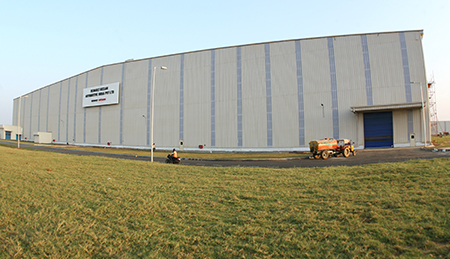
Line one features three different platforms and eight models, and even more derivatives. The M0 platform, a Renault architecture, is used to build the Renault Duster, Lodgy and, most recently, Captur, as well as the Nissan Terrano. The Nissan V platform, meanwhile, undergirds the Nissan Sunny as well as three different Micra versions. Finally, the Nissan K2 platform is used for the Datsun Go and Go+.
The plant’s manufacturing and logistics teams do well to handle the huge variety on line one. However, there are inefficiencies that result from its inherent variations. The Renault Duster and Nissan Terrano, for example, are effectively the same car cross-badged, but with different design and engineering features. Across line one, there are a variety of different process and technical controls for each model.
“The Renault body structure for Duster is sensitive, and requires a lot of geometric control, whilst the Nissan Sunny is simpler for mass assembly,” says MacDonald. “We’ve had to beef up our engineering team in the bodyshop to support the dimensional accuracy requirements of the Renault models.”
Such distinctions are replicated in materials handling and the supply chain. The different platforms and models result in around 12,000 part numbers at the plant, with the most variety on line one. There are many different suppliers for parts like roof liners, headliners and carpets, which increase pick-up locations, while also requiring re-sorting and sequencing at the plant after delivery. To manage all the part numbers, around 50% of components move through internal kitting, which requires a lot of space and extra labour. “But we have no choice,” MacDonald says.
A vision for the future on line twoHowever, Renault Nissan has begun to address these challenges in India. Since the end of December 2016, line two uses only one platform to build two models: the Alliance-developed Common Module Family-A (CMF-A), which is used for both the Renault Kwid and the Datsun Redi-Go. The lower variation has had tremendous benefits for simplifying processes in materials handling and production control.
The current setup is the latest stage in a clear evolution. When the CMF-A models were first launched, including Kwid in September 2015 and Redi-Go in May 2016, the K2 Datsun Go/Go+ were also built on line two along with the Micra models, even though the other V platform model, Sunny, was on line one. As sales for Kwid started to surge, with as many as 100,000 back orders at one point in 2016, the plant moved line two onto three shifts, running six days a week.
Initially, even that wasn’t enough to meet demand, and so MacDonald and his team decided to move Micra onto line one, which freed up capacity for Redi-Go as well. But that left line two on three shifts, with line one on two shifts. The solution was to move the Go/Go+ onto line one, which had spare capacity after European exports of the Micra ended. Moving Go/Go+ allowed the plant to run line two on just two shifts. Today, output on line one is about 436 units per day, while line two is around 522 each day.
“Running each line on different shift patterns is inefficient as you have to manage different working times, including higher transport costs for workers and for material,” says MacDonald. “Having the entire plant on the same shifts means we can optimise transport better.”
[mpu_ad]Among the benefits of the consolidated production on line two is that MacDonald could challenge his material flow planners to reduce kitting on the line, since it no longer needs to handle hundreds of different items across five models and three platforms. He admits that the switch back to kanban delivery to the line has been a transition, with plant engineers determining how to avoid too much inventory on the line, but MacDonald sees benefits; for example, less complexity has reduced the need for sequencing, which has freed up both space and labour.
That is not to say that everything is perfectly simple on line two, either, where different manufacturing approaches require varied logistics processes. For example, the bumpers for the Kwid follow Renault’s strategy and are purchased from suppliers, while those for Redi-Go follow Nissan’s principle and are built in-house.
The good news, however, is that the future direction of the plant, as well as manufacturing across the Alliance, resembles line two more than it does line one, according to MacDonald. The plant is slated to gain the CMF-A+, which has the same standards as the CMF-A, and will be used on line two to build small and medium cars. Line one will also see further consolidation as additional models will be introduced using the M0 platform, including the Nissan Kicks.
“Our alliance engineering teams, manufacturing and supply chain management are all starting to work on one single standard: hallelujah!” he says. “It will take a while to flush out the old models but the companies are working together and that is great news.”
A strong supply chainDespite the complexity of its production in India, as well as the country’s own infrastructure challenges, Renault Nissan’s logistics operations are advanced. Logistics management is fully combined across brands, for example. Alliance teams oversee the full scope of ex-works, inbound collections, as well as outbound deliveries, which are executed by logistics providers on contracts that typically last 2-3 years. The inbound network is engineered for consolidation and milkruns to improve efficiency alongside direct supplier deliveries. A network for parts exports and knockdown kit packaging is also in place in Chennai and in Pune.
MacDonald points to a highly localised supply base: 89% of the volume by weight for production is procured from suppliers close to Chennai. “Even the tier two supply base is well concentrated in Tamil Nadu thanks to so much vehicle and two-wheeler production here,” he says. “We encouraged some of our tier ones who were importing to switch to local sources, which helps on total delivered cost (TDC).”
Other supplier clusters in the country are mainly in northern India, close to Maruti Suzuki production in and around New Delhi, as well as in Pune, east of Mumbai. The carmaker avoids using local warehouses in these locations as much as possible, but instead delivers directly to Chennai or through milkrun and groupage networks. According to MacDonald, who was previously responsible for logistics across the Alliance in Europe and Russia, the utilisation rates for Indian trucking are at a good level.
“Our truck fill rate is typically around 74-75%, which is very similar to what we were getting in Europe, and we were happy with that,” he says.
 Price rises following recent trucking regulation changes have led to increased use of rail to the north and north-east of the country
Price rises following recent trucking regulation changes have led to increased use of rail to the north and north-east of the countryOutbound logistics is also run with good consistency, says MacDonald. He does, however, point to a powerful trucking community, which has at times been willing to halt operations in protest. A change in trucking regulation in 2016 has also limited car carrier size and capacity, leading to price increases of about 20-25% for outbound logistics. In response, the carmaker has increased rail usage to the north and north-east, with weekly services. MacDonald and his team would like to increase rail shipments and to use coastal shipping, which they have so far only trialled, but options and capacity remain limited.
While the Oragadam plant benefits from localisation, its international supply chain remains complex. Around 30% of part numbers for most models, or about 5,000 different parts, are imported. These stretch from across the different geographies of the Alliance: for Renault models, many parts come from France and Spain, as well as from Pitesti, Romania, close to Dacia production, and Tangier, Morocco, where Renault has another large plant.
For Nissan, parts come mainly from Japan, China and Thailand, with some from Vietnam. Both the land-based consolidation and shipping routes from these locations to India can be very long – as much as 16 weeks from parts of Europe, for example.
“It is tough to manage that, especially when you are making engineering changes during a launch phase,” says MacDonald.
However, just as the consolidation of platforms on line two has simplified material flow and line feeding, economies of scale in purchasing and engineering have helped to localise a much larger share of part numbers for the shared CMF-A platform: 96% for Kwid and Redi-Go, with almost everything local on these models except for special items like the navigation system and other electronic parts.
“This reduces our global supply chain complexity and improves our TDC,” says MacDonald.
GST – slow steps in the right directionHowever, logistics in India remains very challenging. The holiday season around Diwali, for example, creates large surges and shortages of trucking capacity. Monsoons often lead to closed roads, as well as damaged or flooded facilities. Roads are often highly congested, with access in and out of ports particularly clogged. India has a high number of toll roads, and traditionally long queues at borders for checks and duties, which slows already lengthy transport times.
India’s long-awaited GST, which came into effect in July, is aimed at eliminating many of the different taxes across state lines. However, the early rollout of the tax has been mixed. The government quickly changed several tax rates a short while after initial introduction, including increasing those for some vehicle types, such as SUVs, which have driven growth in the sector. The initial impact appeared negative, with sales dropping, although that effect appears to be wearing off. Still, there are a number of legal and technical uncertainties.
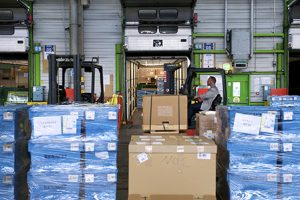 Renault is starting to follow Nissan’s example in using more standard returnable packaging for parts and kit exports
Renault is starting to follow Nissan’s example in using more standard returnable packaging for parts and kit exportsWhile India lags behind markets in Europe and North America in terms of using returnable packaging equipment, Colin MacDonald and his team at Renault Nissan Automotive India say it is a priority to use as much standard and returnable packaging in its operations as possible, as well as to avoid non-degradable material.
However, packaging is an area where differences in the Alliance can still be seen, though they are slowly starting to close. Nissan uses very little disposable packaging, for example, even for parts imported into India from other regions. Renault, on the other hand, has historically used more cardboard, especially for its parts imports and exports.
“If you go into the plant or into a knockdown-kit warehouse, you will see Nissan parts in standard V5 containers and using returnable claps of packaging, where for Renault there is more cardboard and wood,” MacDonald says.
However, things are starting to change. One-way equipment requires extra work and money to dispose of, which can be even more challenging in India than elsewhere, leading to changes in Renault’s processes. “Both carmakers are increasingly sharing and deploying best practices in logistics areas,” he says.
Even within Nissan, most of the packaging is returned to the original shipping location, rather than triangulated to another plant where it may be needed.
“So far, we can only pool on a very limited number of flows globally where it is simple to manage,” says MacDonald.
“Pooling is very complicated, and you could easily end up with a packaging shortage if you do it badly.”
“Overall, the support from the government from both central and state levels has been good, even though it is not without difficulties and we always want things to go faster,” says MacDonald. “We want more infrastructure improvement, uninterrupted power supply, the speedy renewal of licences and less paperwork.
“The GST is a definite step in the right direction but there are many things left to address.”
Changing export strategiesRenault Nissan’s manufacturing operation in India began life targeting exports, at least for the Nissan brand. The plant started exporting the Micra to Europe in 2010, and it eventually grew to be among the most exported individual car models from India.
However, in January 2017, the European version of the Micra moved to a Renault plant in Flins, France. As Europe was the model’s largest market, the shift represents a decline in production of around 55,000 units per year in India.
“The loss of this volume was a bit of a blow to us, but that is the decision that was made and we are moving on from it,” says MacDonald.
Overall, the plant’s export share has fallen from nearly 40% of production in 2016, or around 110,000 units, to around 26% of production this year, with exports likely to finish around 68,000. In response, the plant is building more models geared especially for lower cost, emerging markets.
For example, the Alliance is already shipping the Nissan Sunny to Asia, Africa and the Middle East; meanwhile, about 37,000 units per year of the Datsun Go/Go+ are exported to the Middle East. And although the Micra built in India won’t be updated to the same platform and version as for the European market, the Alliance is studying upgrades of the Indian-built Micra both for the domestic and other export markets, such as Africa and the Middle East.
Renault, which has exported very few vehicles from India, is also increasing overseas shipments, although on a smaller scale to Nissan’s total. The Kwid, for example, is now exported to several Asian countries including Sri Lanka, Nepal, Bhutan and Bangladesh, and this year also started shipping to Africa. The Duster is exported to various markets in Asia.
While vehicle exports from the plant have trended downwards, component exports have been growing for both Renault and Nissan. According to MacDonald, around 100 40ft containers are exported from India every month for each of the two, shipped to more than 20 plants across the world, including Japan and Asia, Europe, the Middle East and South America.
Engine components, for example, are shipped to Spain, Turkey and Brazil. Semi-knockdown kits of the Nissan Sunny, including painted bodies and assembled components, are shipped to assembly plants in Egypt and in Myanmar, along with disassembled knockdown kits of the model to Nigeria.
With parts and kit exports on the rise, Renault Nissan has reorganised its parts logistics strategy. Previously, Renault and Nissan each had an export parts warehouse in Chennai, but both of these have now been combined into an Alliance international logistics network (ILN) facility. Renault also had an existing ILN in Pune that has also been combined into a shared operation, which now includes exporting parts to Europe on behalf of Nissan.
MacDonald points to considerable improvements in overall quality, packaging and parts handling from India. Whereas four years ago, Renault and Nissan had relatively high damage and error rates for export, today its error rate per million parts has been brought down to fewer than ten.
“Everyone is a winner in these exports. If you are building cars in France or the UK, your TDC improves by taking advantage of India’s cost-competitiveness. Our Indian suppliers, meanwhile, can supplement their business with export volumes,” points out MacDonald. “It’s an important strategy to protect both our own profitability as well as the supply base.”
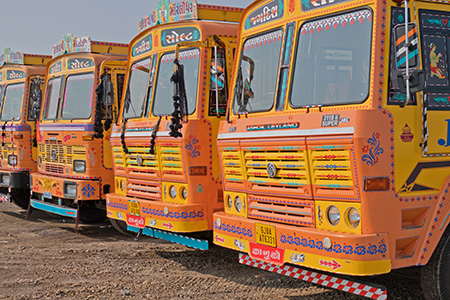 Seasonal trucking shortages, heavy congestion, monsoons and bottlenecks in trucking all mean that road transport in India remains a tricky balance
Seasonal trucking shortages, heavy congestion, monsoons and bottlenecks in trucking all mean that road transport in India remains a tricky balanceAllied in skillsAlthough difficult to crack and even harder to earn margins in, the future of the Indian market looks bright for Renault Nissan. The local product offensive across both brands, particularly in its small car and utility vehicles, should help it continue to gain share. There are high hopes for the Renault Captur, for example, which launched production earlier in 2017 and recently began domestic sales. The next year will see the launch of the Nissan Kicks as well. MacDonald expects annual production at the plant to surpass 400,000 units in the next 3-5 years and approach its capacity.
Just as there has been progress in India in sharing and combining engineering, production and the supply chain, MacDonald sees further integration of human resources across the Alliance as just as important. When he first came to India in 2014, MacDonald noted that the management team at the plant was more weighted towards Nissan, reflecting the carmaker’s larger ownership share. MacDonald, who himself started at Nissan in the UK but has since held Alliance-wide roles, set out to add more managers with a background at Renault.
“I wanted to make us more Alliance-orientated in planning and management,” he says. “We have to be able to work in both brands’ world every day, because they are still not homogenous. We need people to understand the terminology and vocabulary of both companies.”
MacDonald has also sought to develop a more local management team in India, recruiting and training local employees who don’t come with previous expectations or loyalty to one brand over another, and thus are more inherently comfortable in both Renault and Nissan “worlds”. Over the next three years, he expects the number of expats working in the plant in India to reduce dramatically.
[related_topics align="right" border="yes"]By the same token, he hopes to take more Indian talent outside the country to other Alliance locations. Up to now, he admits, only a handful of Indian managers from the plant have been sent overseas. The numbers from R&D and IT are higher, but he believes such development should be increased, both to the benefit of the local operations and the wider company.
“We need our younger engineers to go and understand other parts of the Alliance so that they can come back older and wiser and apply useful experiences here in the plant and the supply chain,” MacDonald says. “Developing our talent is a key success factor for continued improvement and sustainability.”
"We need our younger engineers to go and understand other parts of the Alliance so that they can come back older and wiser and apply useful experiences here in the plant and the supply chain. Developing our talent is a key success factor for continued improvement and sustainability." - Colin MacDonald, Renault Nissan Automotive India
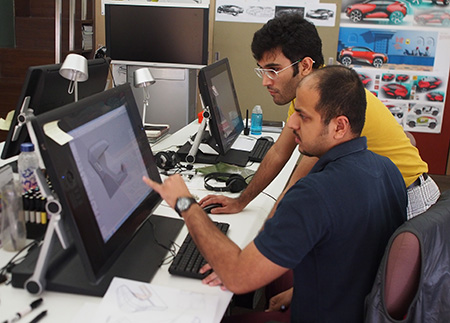 The RNTBCI is involved with a range of R&D activities, from extending the company’s MRP system to developing a new breed of low-cost AGVs
The RNTBCI is involved with a range of R&D activities, from extending the company’s MRP system to developing a new breed of low-cost AGVsOne of the major advantages of Renault Nissan Automotive India is its captive R&D division, the Renault Nissan Technology Business Centre of India (RNTBCI). The R&D group is in Chennai, close to the plant in Oragadam, connecting the manufacturing and operations team closely with development engineers. RNTBCI has around 6,000 engineers, including 2,000 software developers; about 80% of the work they do is for global operations across the Alliance.
“As both the R&D and the plant operation are still young, we occasionally have teething problems during launches and start of production that take longer to stabilise, but that is constantly improving,” says Colin MacDonald.
The plant’s proximity to these engineers has helped address a number of IT and supply chain issues. For example, RNTBCI helped to develop an extension to Renault Nissan’s manufacturing resource planning (MRP) system specific to India that includes peripheral, web-based features key to the market, such as visibility of material and vehicle inventory in the production pipeline.
“Our MRP screens are pretty basic and would require three or four screens to see all of our production and inventory data,” explains MacDonald. “We worked with our local software guys with R&D support, who in a short space of time were able to develop a process that extracts data out of the mainframe system into a secure data warehouse, which we can then access and see on web-based screens in a user-friendly way.”
The software team has also helped the logistics team to develop and implement a warehouse management system, which the carmaker has now rolled out across its manufacturing operations in India. Previously, plant workers controlled warehouse and inventory using spreadsheets.
The local R&D team is set to be even more involved in improving material logistics and in-plant efficiency. The Oragadam plant has low levels of automation, thanks to India’s still relatively cheap labour rates. That goes for in-plant logistics handling as well, which is managed and operated entirely by in-house staff. Currently, for example, there are no automated guided vehicles (AGVs) moving between kitting zones and supermarkets, or other kinds of automated storage and retrieval. Workers push karts or drive lift trucks.
Although the plant, excluding depreciation, ranks as the fifth lowest cost globally for the Alliance (Mexican plants have the lowest costs), MacDonald says that the lack of automation is hurting the factory’s productivity measurements. Indian wages are also rising fast, albeit from a low base. MacDonald’s vision is thus to introduce a fleet of basic AGVs developed by local engineers.
“I have challenged our local R&D team to strip down an AGV and to figure out how to make the world’s cheapest but scalable AGV,” he says. “We have already done some small-scale pilots in the trim and chassis area just to get the engineering and production guys thinking about how we should do this.”
Several prototypes are already under development for the AGV and MacDonald expects at least some versions of it to be in use during 2018. “It will be a great example of taking advantage of Indian engineering, materials and technology to make it cheaper, but still effective,” he says.

























![Global[1]](https://d3n5uof8vony13.cloudfront.net/Pictures/web/a/d/s/global1_726550.svgz)









